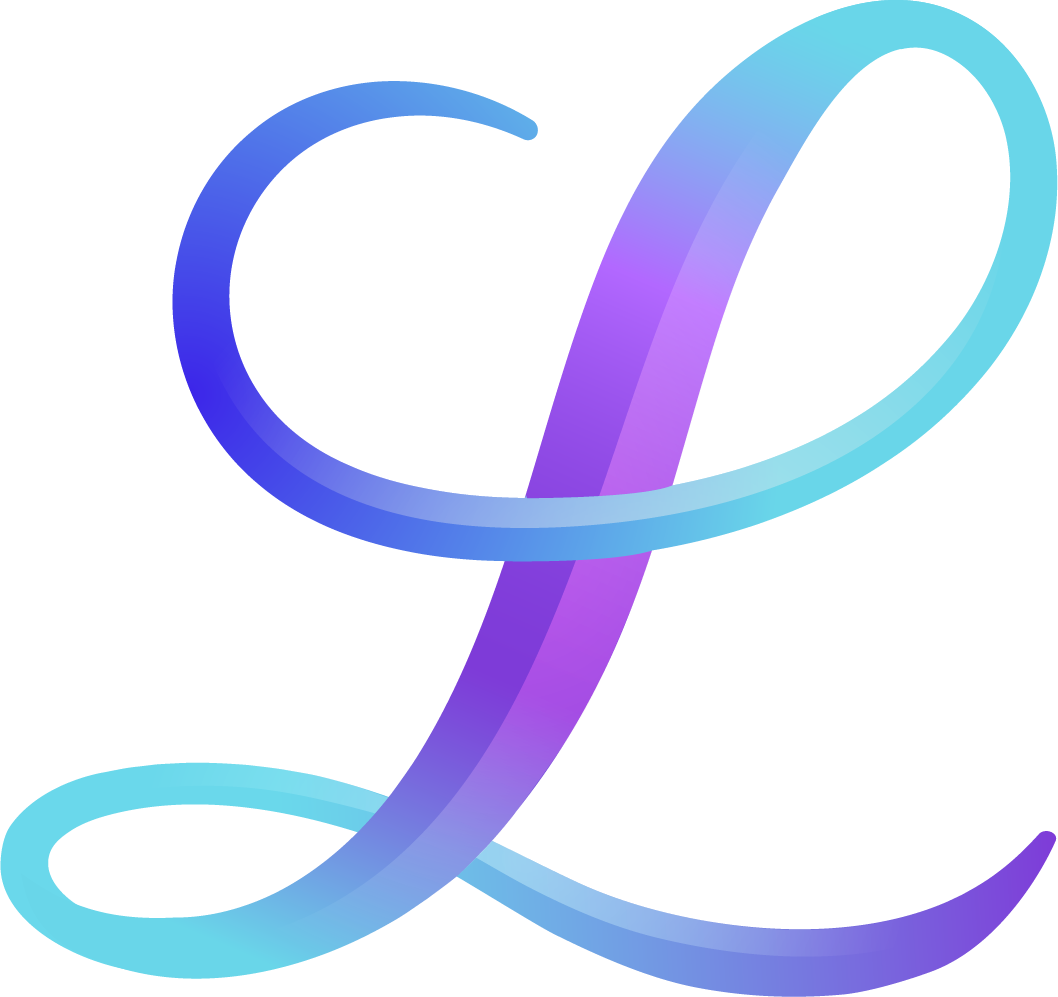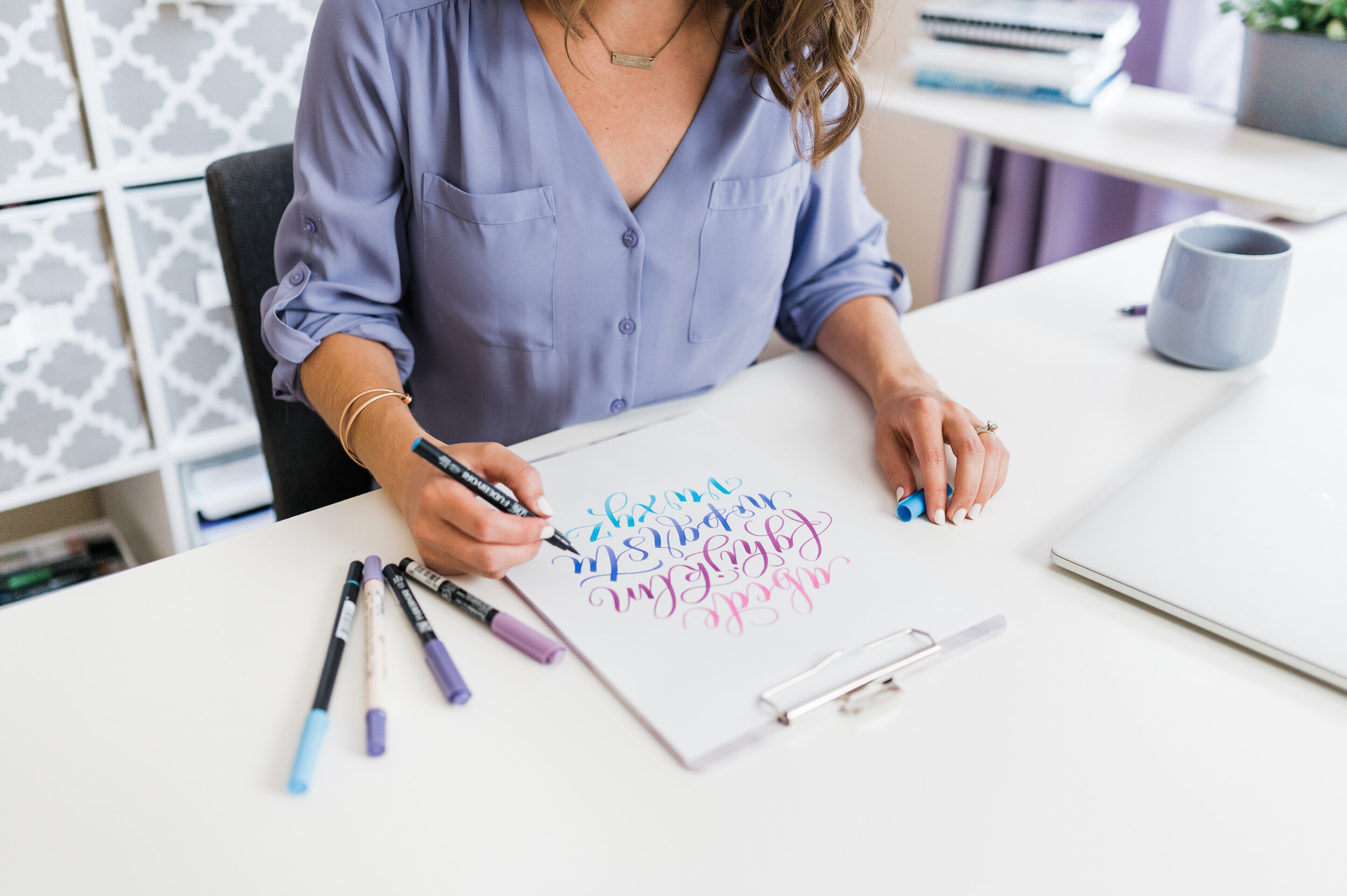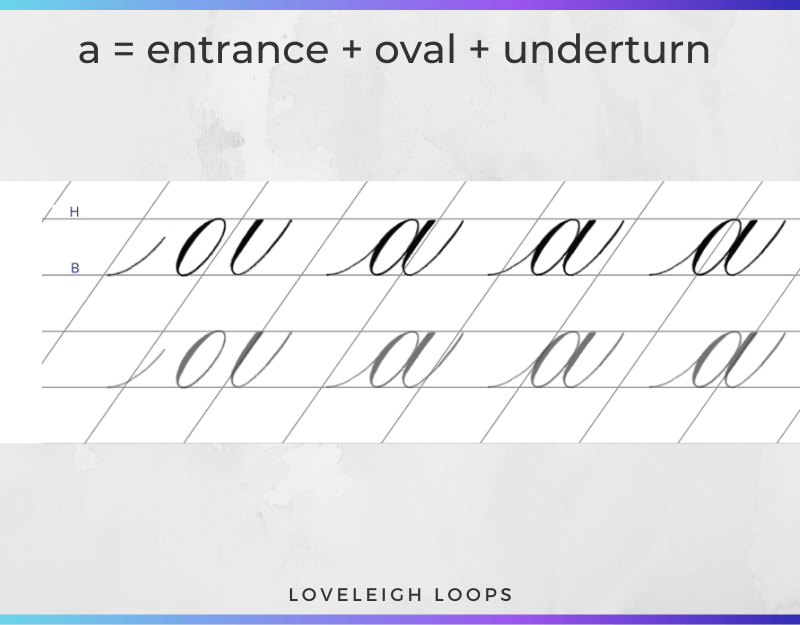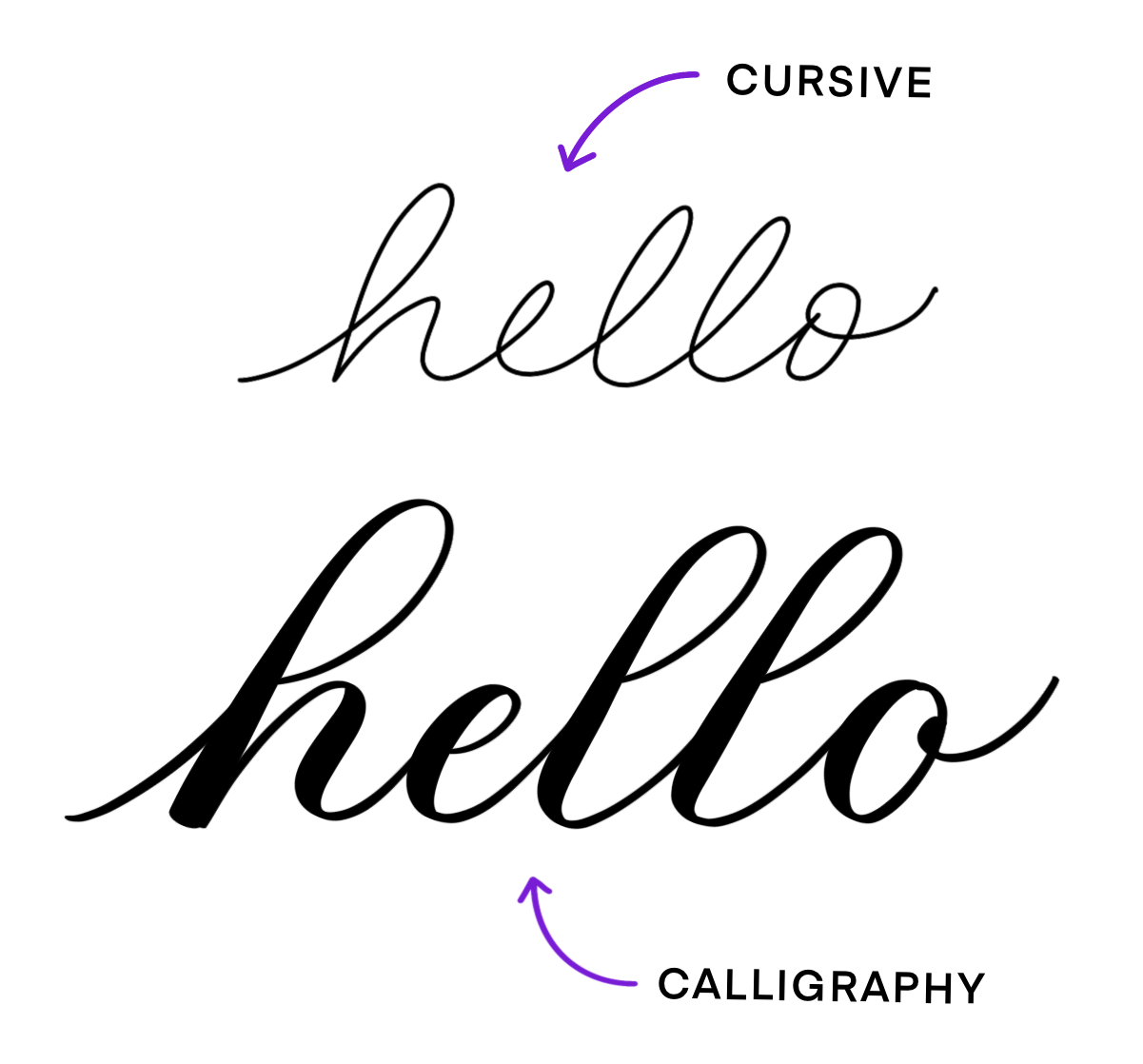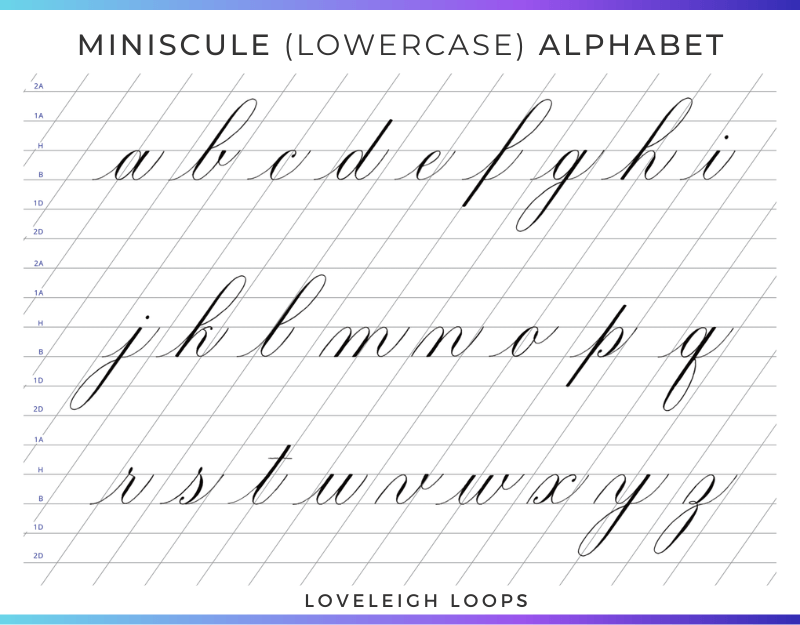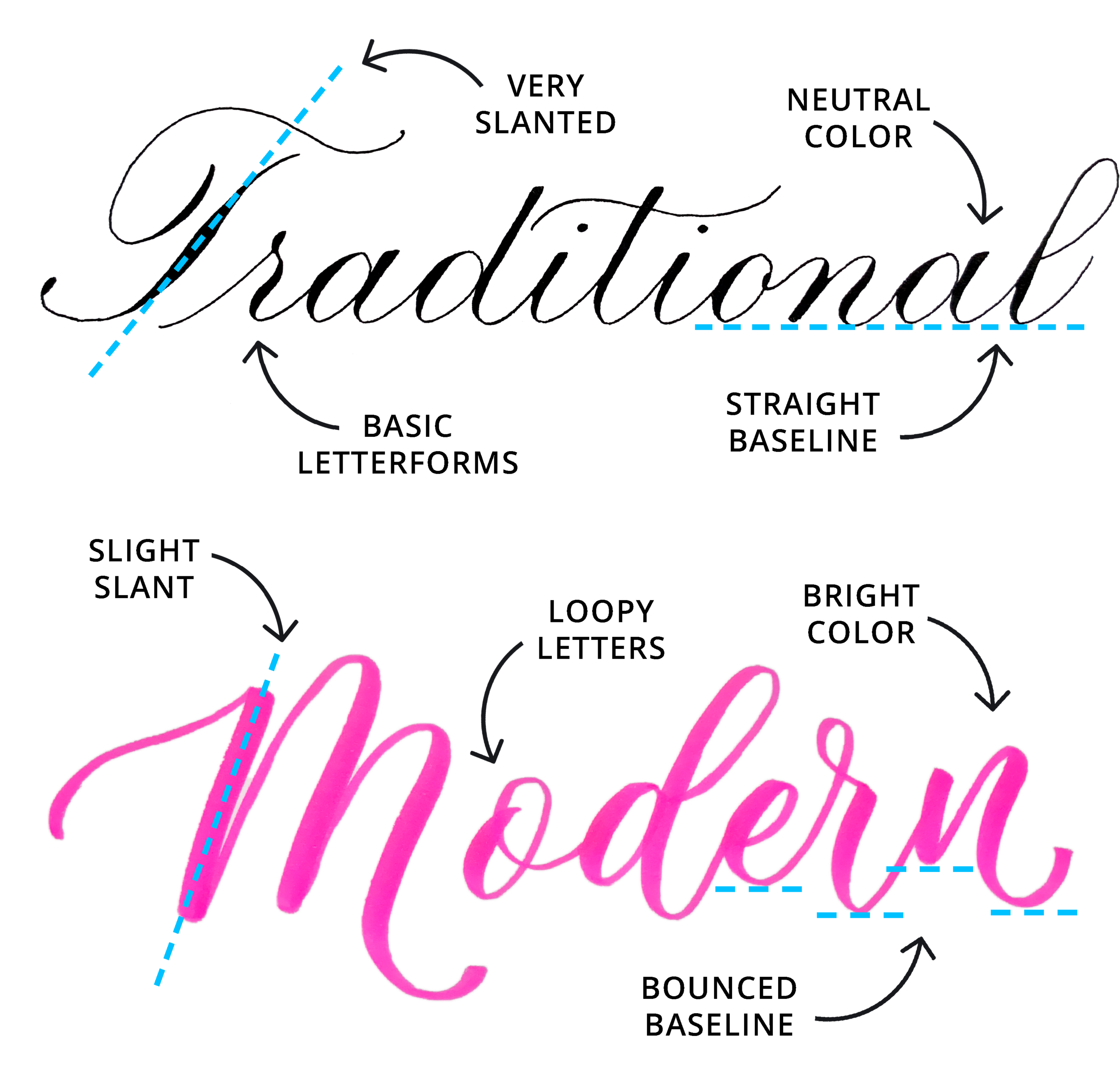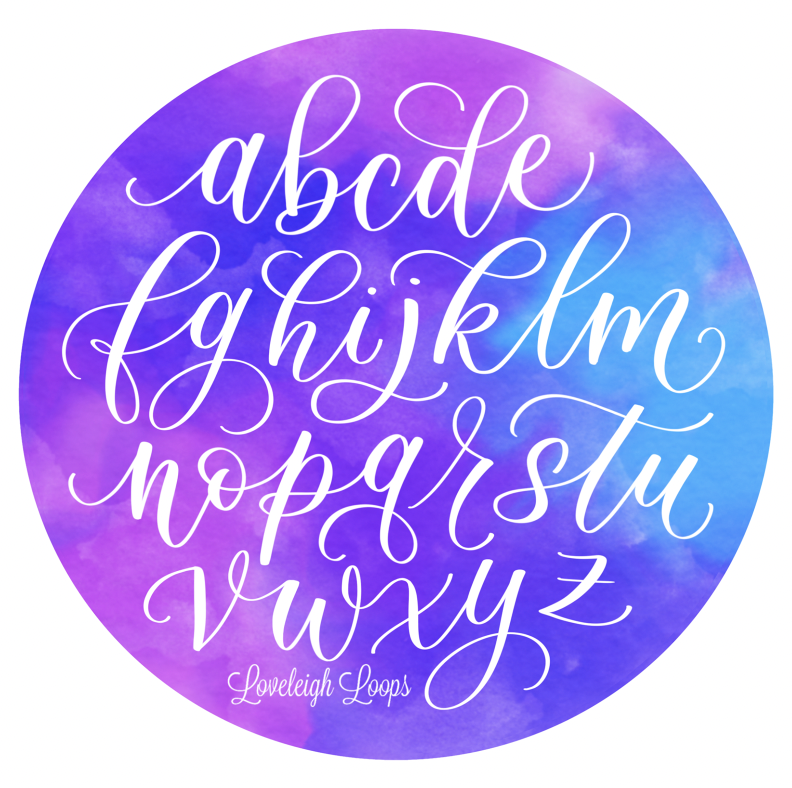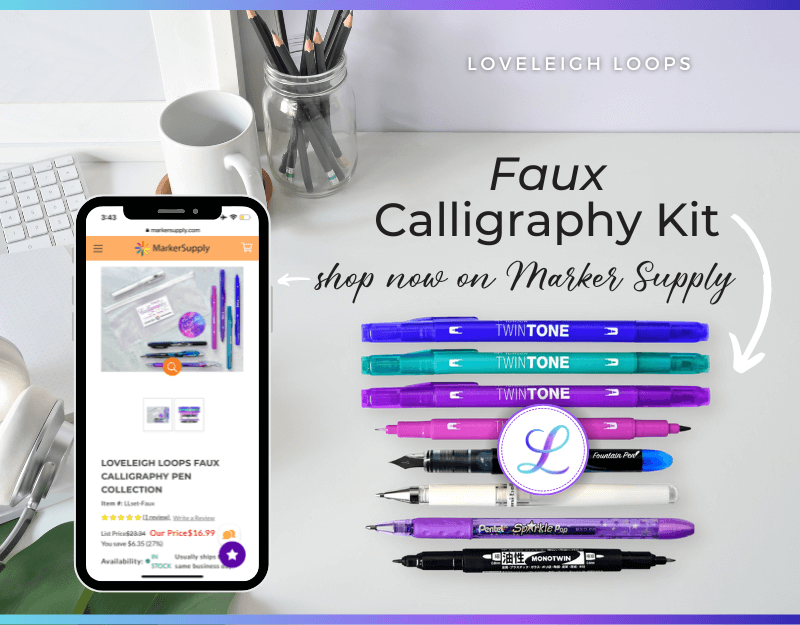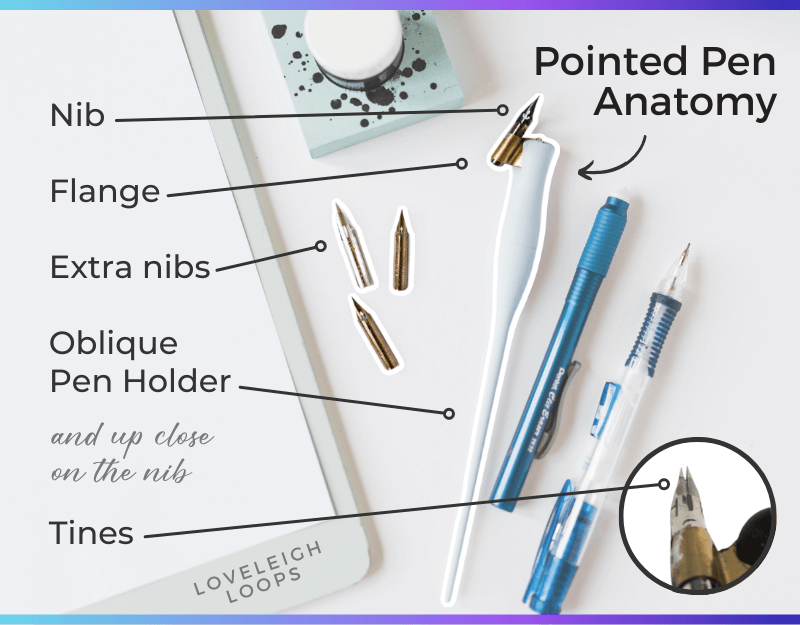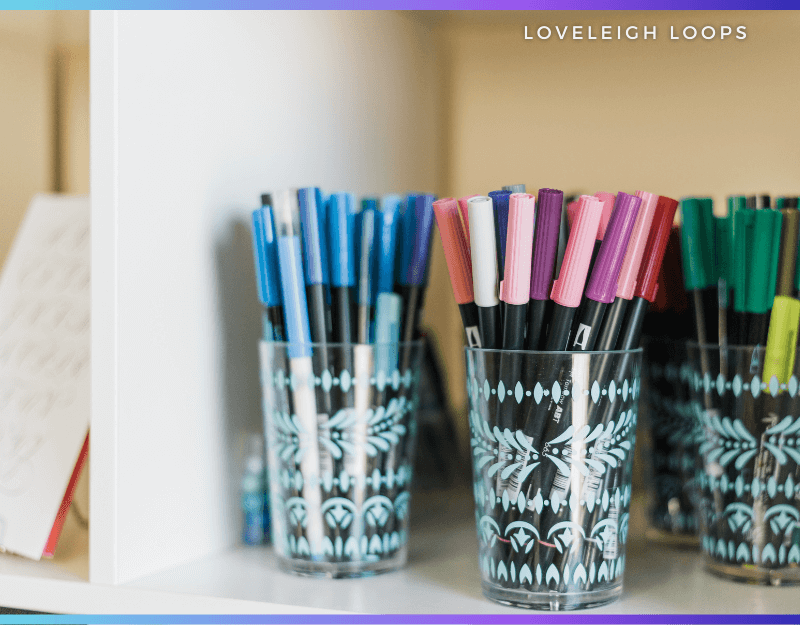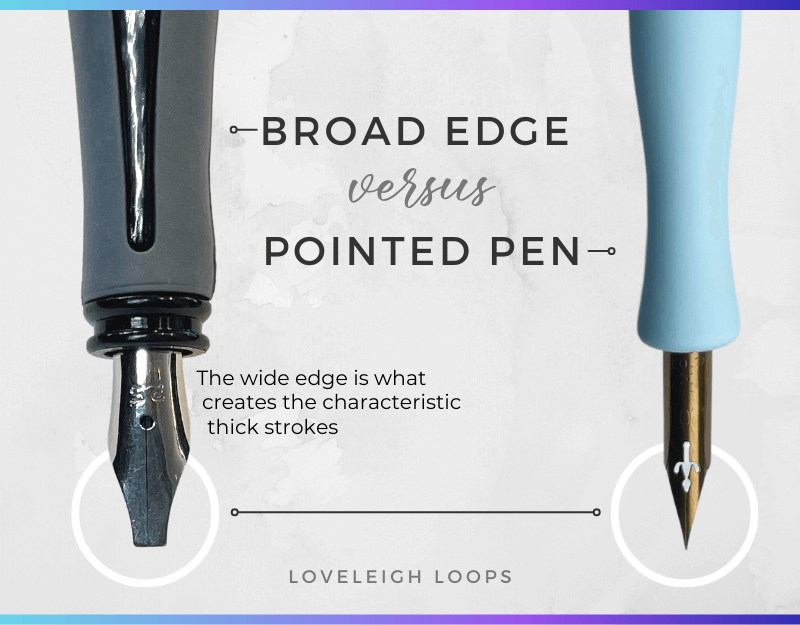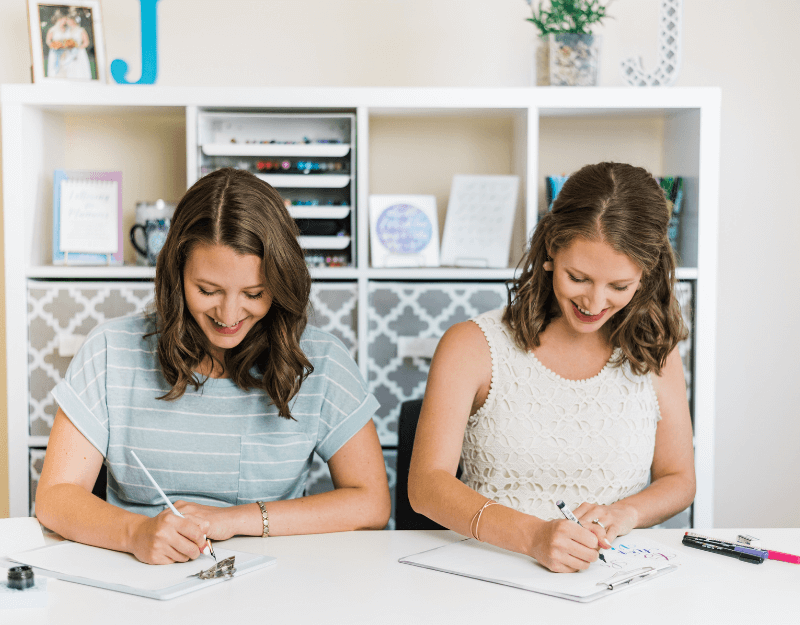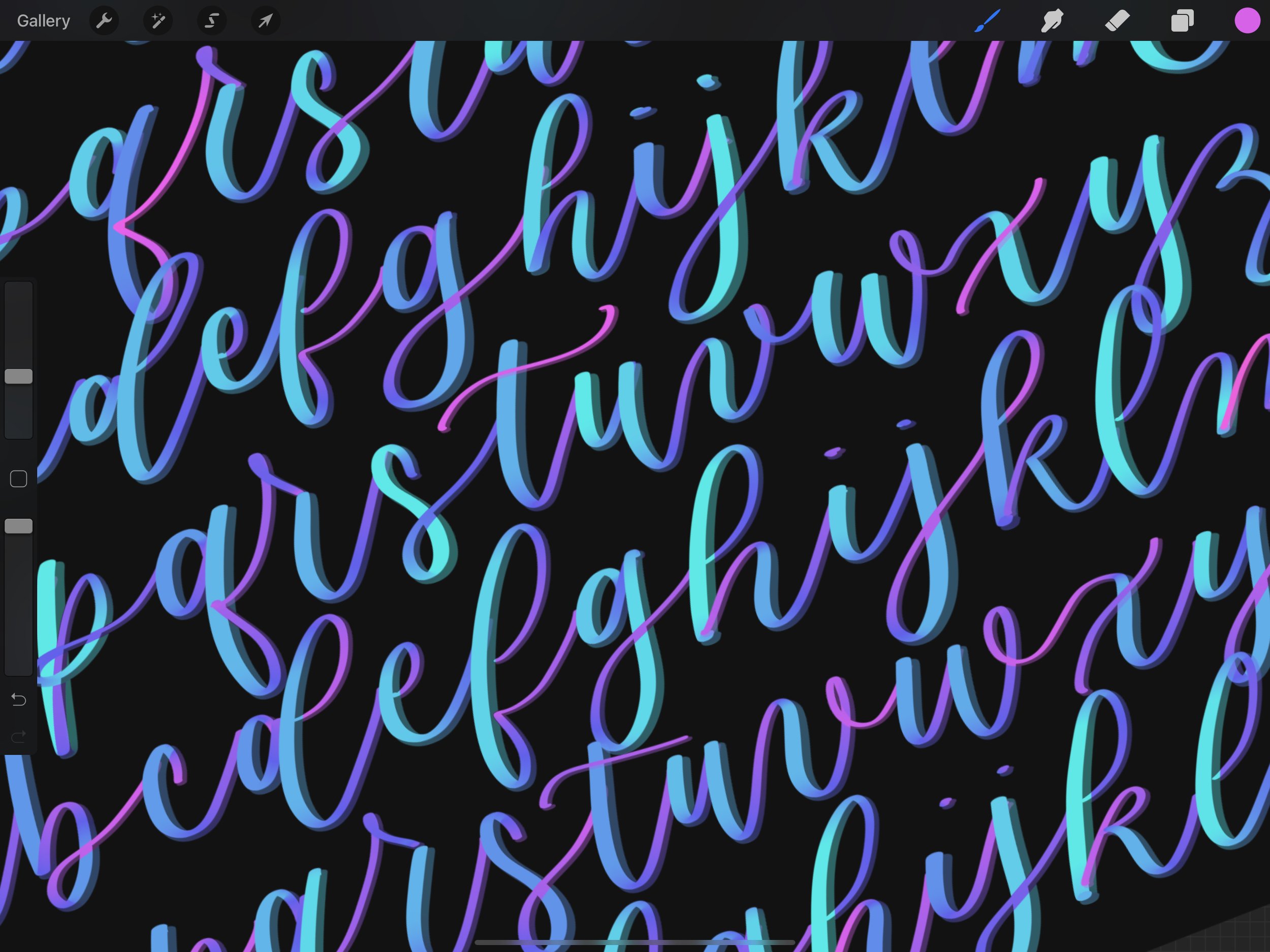How To Learn Calligraphy From Scratch [FREEBIES]
Learning calligraphy is something everyone can do. That means you, too!
While calligraphy skills may look mystifying and mysterious, this is a very predictable (and therefore learnable) craft. You don't need to have great handwriting already or think of yourself as a creative person.
Pin it for later! ↓
All you need to learn calligraphy is:
The desire to learn
Any writing utensil
Any piece of paper
Teachers
...that's where we come in!
We're Jordan (left) and Jillian (right), the twin sisters and calligraphy teachers here at Loveleigh Loops.
We are SO glad that you’re here!! We’re going to walk you through every step, from calligraphy newbie to lettering master
Tens of thousands of students have taken our calligraphy courses, and we are SO excited that you're going to join in the fun.
Let's dig into how to learn calligraphy.
Table of Contents
Why learn calligraphy?
There are many reasons why people still learn calligraphy, even in an age where physical handwriting of any kind may sound old-school. From hundreds of survey responses, these are the top 3 most popular reasons why people want to learn calligraphy:
Relaxation. Lettering is relaxing, satisfying and therapeutic. When so much of life is digital, a physical hobby is incredibly positive and rewarding. The mental benefits are endless.
Accessibility. Sure, special ink and pen nibs don't grow on trees; but the calligraphy basics can be found everywhere (probably in your home already). A brush pen only costs a few dollars.
“You” time. While you can turn calligraphy into a business, most calligraphers turn to this hobby for the intrinsic rewards.
It's true that calligraphy hasn't been a mainstream skill for a long time. Even cursive writing has declined in popularity; it was removed from the Common Core State Standards (CCSS) in the United States in 2010, which led many schools to stop teaching cursive writing altogether.
Does that mean that fewer people are learning calligraphy? NO.
Calligraphy is as popular as EVER
While technology (namely typing) has reduced the popularity of cursive writing, social media has popularized calligraphy and beautiful handwriting. Calligraphers garner enormous followings online, where students tune in from around the world to learn this craft. We’ve gotten over 15 million views on our YouTube calligraphy videos!
Through our online calligraphy courses, we've personally taught 40,000+ students in more than 150 countries. We share free tutorials a couple of times a week on social media with another 150,000+ followers. You can join us too, if you'd like!
The interest in calligraphy skills is gaining momentum, not losing it.
What is calligraphy?
Calligraphy is the art of writing beautifully. With handwriting (such as cursive), your goal is usually speed and legibility. Calligraphy focuses on elegance, beauty and consistency. When you write calligraphy, it takes longer than normal handwriting, but the result is more beautiful letterforms.
What is calligraphy? Simply put, calligraphy is the art of beautiful writing
Instead of writing entire letters at once, calligraphy letters are written using a set of specific strokes. These strokes, called the basic calligraphy strokes, are what distinguishes calligraphy from ordinary handwriting.
Once you start learning calligraphy, you'll notice that calligraphy is all around you: on cards, important documents, online, at museums.
The word calligraphy has its roots in Greek, and stems from two words: kallos (κάλλος ), which means "beauty," and graphein (γράφω), which means "to write." Here's a special example of calligraphy written on a shell on display at the Hellenic Maritime Museum in Athens (though it’s not in the Greek alphabet, and it didn’t include a date!):
You’ll start noticing calligraphy all around you!
You may also like: The History Of Calligraphy
Can I learn calligraphy if my handwriting is awful?
Yes, you can learn calligraphy even if you have bad handwriting. Calligraphy is very different from normal handwriting and actually uses a different set of muscles.
Instead of "improving" your handwriting, you should see calligraphy as learning to write letters in a new way.
How is calligraphy different from normal handwriting?
In normal handwriting or cursive, you write letters one at a time. In both traditional and modern calligraphy, you write letters one stroke at a time.
For example, the letter "a" is written in one motion in cursive. But when you write the same letter in calligraphy, it's composed of 3 separate strokes:
This is achieved by lifting your pen after each individual part of the letter.
By focusing on balance, precision and consistency in every stroke, you're able to create beautiful calligraphy letters no matter how your handwriting looks.
You may also like: Cursive vs Calligraphy
Which calligraphy style is easiest to learn?
The easiest style of calligraphy to learn is faux calligraphy. If you want to try calligraphy without buying special pens or paper, faux calligraphy is the perfect place to start.
Faux calligraphy is the easiest form of calligraphy because it doesn't require pressure control (which we'll get to in a minute) or special tools, but the result can look exactly like calligraphy when you're done.
Are you ready to write your first word in calligraphy?? We have more to show you (other styles, tools, free worksheets, etc.) and we'll get to that in a minute, but let's take a step back from the theory and start writing calligraphy.
Real calligraphy versus faux calligraphy
You may also like: How To Do Calligraphy With A Normal Pen
How To Write Your First Word In Calligraphy
Time to do some actual calligraphy!! Calligraphy is an exciting hands-on hobby in the sense that you can get started writing right away with whatever you have.
We'll show you right now with a mini-project using faux calligraphy.
Follow along with the written instructions or in our video tutorial:
For this little demonstration, you only need two things: a writing utensil (pen, pencil, marker, crayon, etc.) and a piece of paper.
You can even use your iPad and Apple Pencil! Learn more about iPad calligraphy in our guide.
Calligraphy is a joyful hobby, so we're going to use the word "joy" in this tutorial :)
The word “joy” written in calligraphy step by stepy
1. Write Your Base Word
Start by writing the word joy on a piece of paper in cursive. We're going to go back in and add shade to your lettering, so make sure that your word is written slightly larger than you may normally write.
Also, don't feel bad if you don't know cursive! Just write the letters in such a way that the letters are connected and look similar to the style in the picture above.
When your word looks something like the picture, you're good to move on to the next step.
2. Outline Downstrokes
Now, we'll add some thickness to certain parts of the letters. For each letter, add your thickness as follows:
Letter j: Add a little parallel line on the left side of the part that goes down
Letter o: Draw a line on the left side of the oval
Letter y: Here we have to thicken two parts; the long loop going down as well as the little loop on the left.
Can you see a pattern here? Hint: look at the direction in which you move the pen...
How to add downstrokes to your word
Thickness is added each time your pen moves down the page (towards you). This is called a downstroke.
When your pen moves up the page (away from you), that's called an upstroke. This is thin.
This is fundamental to writing calligraphy:
Upstrokes are thin
Downstrokes are thick
See how some parts are thick and some parts are thin? That’s fundamental to writing calligraphy
We'll go over this more in a minute; for now, let's keep going with the word "joy."
3. Shade Letters
Finally, take your pen or pencil and color in the areas between the parallel lines that you just drew. These darkened areas are all shade.
Now that's a big difference isn't it?? By adding a subtle shading effect, you've made your letters look a lot more professional and dare I say (a little) more elegant.
Here’s another example of how shading your downstrokes transforms normal writing into calligraphy:
Turning the word graittude from normal cursive into calligraphhy by adding shade
Congratulations - you've just written your first word in calligraphy! Welcome to the group :)
P.s. We have a *literal* group if you'd like to meet some friends along your calligraphy journey! It's a free Facebook group.
Different Styles Of Calligraphy
Calligraphy is an art form that's as old as the written word, and many different types of calligraphy have been developed throughout the centuries.
The sheer number of alphabets and styles means that there's something out there for everybody. Here’s a glimpse of how diverse the styles are:
The word gratitude written in 6 different calligraphy styles
These styles are just the tip of the iceberg. If you want to see incredible style variety, look at our #1 most popular calligraphy alphabet blog post. It showcases 60 styles of the alphabet from our talented students!
Faux Calligraphy
Although faux (fake) calligraphy is technically adapted handwriting as we saw above, it deserves a proper mention since it's the most beginner-friendly style of calligraphy.
The faux calligraphy alphabet
In true calligraphy, you create contrast by pressing your flexible calligraphy pen harder on the page when writing down strokes. The increase in pressure results in thicker strokes.
Even absolute beginners can do faux calligraphy since it doesn't require as much technique as some of the other styles. That being said, many seasoned calligraphers still love this style and refine it:
You may also like: Easy Calligraphy For Beginners
Copperplate Calligraphy
Many people love learning traditional calligraphy scripts, with the most popular being Copperplate. It's a style with a long history and many vibrant interpretations, from basic letterforms to elaborate flourishes.
Sometimes the name "English Roundhand" is also used to refer to this style.
The Copperplate lowercase alphabet
This script was popular in the United States and England in the 17th and 18th centuries, where words were engraved onto a copper plate.
It was popularized by the book The Universal Penman by George Bickham, and was originally written with a feather pen. Now it's written using a pointed pen (sometimes called a dip pen), a nib and liquid ink. We'll show you the exact supplies we use in a minute.
Here’s an introduction to this calligraphy style:
Copperplate is one of our favorite styles, and we have TONS of resources for you to learn:
Due to its prominence, Copperplate is often referred to as "traditional calligraphy," even though it's technically only one of the many traditional styles.
You may also like: Intro to Pointed Pen Calligraphy
Here's another traditional style...
Spencerian Script
The Spencerian script is also a traditional script written with a pointed pen, but it has a different set of basic strokes and a different angle.
If you like the idea of being part of the long tradition of calligraphy, then this beautiful calligraphy style could be right for you. It was created by Platt Rogers Spencer in the nineteenth century, and during its heyday, was seen as the "quintessential style" of American handwriting.
The Spencerian script alphabet
Did you know that some people even do traditional scripts using modern tools like the iPad?
We love the way a style like Spencerian script looks when we use it for digital art. We have an entire course that teaches Spencerican Script on the iPad.
Here's a glimpse of how this traditional script can look when written digitally:
Blackletter
Blackletter script is sometimes also called Gothic script, Textura or Gothic minuscule and it was used in Western Europe from approximately 1150 until the seventeenth century.
It's an old script, but it's still around today: you may recognize Blackletter from your local newspaper's masthead.
We don't teach Blackletter here at Loveleigh Loops, but we are lucky to know the incredibly skilled Tamer Ghoneim of Blackletter Foundry.
We've taken Tamer's Blackletter Masterclass and it's the top resource we recommend for learning Blackletter calligraphy.
Modern Calligraphy
Traditional scripts follow a very specific set of rules. Modern calligraphy, on the other hand, treats those rules as guidelines.
Modern calligraphy is an umbrella term that covers all non-traditional styles and tools. You can even develop your own unique calligraphy style.
Traditional vs modern calligraphy
Our advice: learn the rules, then break them. The fundamental calligraphy skills (consistency, muscle memory, etc.) will be essential to your work no matter how unique the style is.
You may also struggle to follow tutorials if you don't have the basics down.
For example, we have a free style development printable that walks you through the step-by-step process of creating new word styles, but you still need to know your ascenders from your descenders to follow along.
Variations of the modern calligraphy alphabet
Let's look at a few of the most popular modern calligraphy styles.
Brush Lettering
Brush lettering is sometimes also referred to as brush pen lettering or brush pen calligraphy. Not to be confused with brush calligraphy, which is a less common form of calligraphy done with a paintbrush.
It's a form of modern calligraphy written with a brush pen (a calligraphy marker) that has a flexible tip that allows you to create thin and thick strokes through pressure.
Bounce Lettering
A common stylized version of brush lettering is bounce lettering. The modern calligraphy style takes the normal letterforms and extends them beyond their normal shape, making the letters appear organic and... bouncy!
Take a look the next time you're browsing through greeting cards or framed artwork at Target and you'll notice this modern calligraphy style everywhere.
The bounce lettering alphabet
We teach this style step-by-step in our beginner bounce lettering tutorial:
Flourishing
Calligraphy flourishes are elegant extensions that embellish words and make calligraphy even fancier than its normal form. These are purely decorative, and can span normal letter embellishments (like you see below) and go all the way to entirely decorative elements like bird flourishes.
Flourishing is an advanced calligraphy technique that you can only move onto after understanding the basics, so if these mesmerizing twists and turns catch your eye, start learning the basic letterforms now.
Learn more in our flourishing beginner's guide, our free flourishing course or our flourishing membership.
Hand Lettering
Hand lettering is an umbrella term that refers to any lettering that's drawn instead of written. The end results will be beautiful words, but there are no basic strokes to adhere to with hand lettering! A lot of lettering art falls into this category.
A common type of hand lettering is 3D lettering. See these examples by Stefan Kunz:
We don't teach this type of hand lettering, but our friend Stefan Kunz is an incredibly talented hand lettering artist who wrote a 3D lettering guide for Loveleigh Loops readers:
Calligraphy Tools And Supplies
Although you don't need much to start learning calligraphy, there are many types of tools that you can experiment with.
Few people still use quills. Calligraphy pens like a Pilot parallel pen or simple pointed pen nib and ink remain popular choices for calligraphy artists.
Types of calligraphy pens and the styles they're used to write
Browse these calligraphy tools and more favorite supplies in our Amazon Storefront:
Monoline Calligraphy Pens
Mostly used for faux calligraphy or hand lettering, monoline pens are writing utensils that write a consistent line no matter how much pressure is applied.
For example, think about applying a lot of pressure to a ballpoint pen versus applying pressure to a Crayola marker. A Crayola marker would create thicker lines, but a ballpoint pen will always create lines of the same thickness.
Our top monoline pen recommendations:
Our custom Loveleigh Loops monoline pen kit: Loveleigh Loops Monoline Pen Collection
Pointed Pen (Dip Pen)
The term "calligraphy pen" refers to a pointed pen holder (the pen body that you hold) with a nib (the pointy tip where the ink comes out). This is what you need to do many styles of traditional calligraphy.
Our top pointed pen recommendations:
The pen holder: Moblique 2-in-1 Penholder
The nib: Nikko G Nib
Pointed pen anatomy
When you start learning calligraphy, learning how to use a pointed pen is part of the learning curve. Since the nib in an oblique holder is at an angle, it takes some practice to get the hang of it.
Choosing a beginner-friendly nib can help. Check out our recommended tools for pointed pen calligraphy for the best nibs for beginners.
Although an oblique holder takes some getting used to before you can use it with confidence, its so satisfying when your pointed pen starts to feel comfortable.
Learn how to put the nib and pointed pen holder together in our tutorial:
You may also like: Popular Supplies for Traditional Calligraphy
Brush Pen
Just like the name suggests, a brush pen is a combination of a brush and a pen that gives you the best of both worlds.
The flexible tip of a brush pen lets you apply different levels of pressure to create lines of different thicknesses. Apply pressure for your thick downstrokes and lift some pressure to create thin upstrokes.
We love brush pens because of the huge variety of shapes and colors that they come in.
Brush pens are only a few dollars each, so the more the merrier!
Easy tip: For beginners, we recommend choosing a brush pen with a larger tip for your first brush pen.
Our top brush pen recommendations:
Broad Edge Pen
Mainly used for Blackletter calligraphy, the broad edge pen is a pen that has a wide nib rather than a pointed one. Unlike pointed pen or a brush pen, you create thick and thin lines by changing the direction of the pen.
It's not hard to see that learning how to use a broad edge nib is easier than a brush pen or nib.
A broad edge pen versus a pointed pen
Our top broad edge pen recommendation:
Most popular: The Pilot Parallel Pen
Sakura Pigma Calligrapher
Pencil
While you can 'fake' calligraphy with a normal pen, using the humble pencil lets you create lettering that truly falls in between fake calligraphy and the real thing.
A softer pencil still allows for drawing lines of varying thickness which makes pencil calligraphy an excellent place to start for anyone interested in developing their calligraphy skills. Any pencil will work! No need for special tools.
You may also like: Our Favorite Lettering Supplies
Apple Pencil
Who said you need paper to do calligraphy? We'll never stop doing pen and paper calligrpahy, but we're also huge fans of doing iPad calligraphy. With the Procreate App and the Apple Pencil, you have everything you need to create stunning digital lettering art.
At Loveleigh Loops we love iPad calligraphy so much that we've even created a free course where we cover all the basics to help you get started!
Our top digital calligraphy recommendation:
Best Budget choice: Base iPad model and the 1st Gen Apple Pencil
For multitasking: iPad Air and the 2nd Gen Apple Pencil
For portability: iPad Mini and the 2nd Gen Apple Pencil
For the biggest screen: iPad Pro 12.9-inch and the 2nd Gen Apple Pencil
We go through the pros and cons of each of the iPad models in our Procreate iPad Buying Guide.
Ink
When you choose to use nibs, you choose to use ink! Ink presents a learning curve, but fortunately, the most common ink problems are easily fixed and we would encourage you not to be dissuaded from getting into pointed pen calligraphy.
A pointed pen writing in calligraphy ink
Our top calligraphy ink recommendation:
Black: Sumi
White ink: Dr. Ph Martin's Bleedproof White
Sepia: Walnut Ink
Multiple colors: Dr. Ph Martin's Bombay India Ink
Paper
While all types of paper might look alike, they're not all the same. In fact, some paper can actually destroy your writing tools.
Always use 'smooth' paper when using brush pens or a pointed pen as the rough surface of low-quality paper can fray the tips of them.
Our top paper recommendations:
For brush lettering: Canson Marker Paper
For pointed pen: HP Premium 32lb Paper
Learn more about these options in our guide to calligraphy paper.
The Fundamentals Of Learning Calligraphy
Shading is an important part of calligraphy and learning how to shade as you're writing letters is a fundamental part of learning calligraphy. This comes from pressure control and muscle memory, and there are a few basic principles that simplify this process. The first is the basic calligraphy strokes.
Basic Calligraphy Strokes
Let's take a closer look at the shading we did for our first project. When you thickened part of the letters in the word joy, you weren't randomly adding parallel lines.
You added shade every time you moved the pen toward you. Those areas are the downstrokes of the letters.
Looking at the letters j and y, you can see that the long loops going down are virtually identical. They are of similar length, written at the same angle and have shading in the same spot.
In calligraphy, you learn a few strokes instead of 26 letters of the alphabet
This idea of finding similarities between letters and the way you move the pen brings us to something that's at the heart of calligraphy: the secret to consistent writing lies in mastering strokes, not letters.
Try thinking of it this way: it's faster to learn and perfect 7 strokes versus 26 letters.
Calligraphers have found that you only need 7 pen movements to make all lowercase letters. These individual movements are called the basic calligraphy strokes and learning them is an essential part of learning calligraphy.
With this image, you can see that the letter y is in fact a combination of an underturn and a descending stemloop. How would you make the letter g? And what about the letter a?
Consistency
Using the basic calligraphy strokes is a great way to make your letters look more consistent.
When you practice your basic calligraphy strokes, the most important goal is to get your letters as even as possible.
Keep in mind that consistency is more than just making your letters all the same size. In this example, you see how getting your thicker parts all the same thickness makes a huge difference.
Copperplate calligraphy being written with a pointed pen
Aim for consistency in the following areas:
Height: Make all your stemloops of identical height (and the same goes for every t, p and d)
Slant: Keep your strokes at the same angle (55 degrees for traditional calligraphy; modern calligraphy can vary)
Thickness: Aim for downstrokes with the same amount of shading
Loops: Make sure your stemloops and ovals are all of identical 'roundness'
Consistency is easier to achieve when you use a worksheet. We have a free basic strokes worksheet that you can get instant access to now:
We have 20+ free worksheets, which you can browse in our calligraphy worksheet library.
Learning calligraphy takes time but you'll see improvement after just a few practice sessions.
Writing Speed
By now you've seen how writing calligraphy is so different from normal, quick handwriting. Speed who?! No one's in a rush when writing calligraphy. It's about putting in the effort to make your writing as beautiful as you can.
Keep writing speed in mind when you watch lettering videos. Many writing videos online are sped up so that the whole video can be published in 60 seconds (ours included on platforms like Instagram and Facebook).
To get a real sense of writing speed, here's a real-time video of Jordan writing "relaxing" with a pointed pen in the Copperplate style with flourishes:
How To Practice
When you see examples of beautiful calligraphy on Pinterest or YouTube, you're seeing the result of repetition and muscle memory.
Just like playing the piano or learning a language, it takes practice to learn how to write calligraphy. Even professional calligraphers practice often to build and maintain the muscle memory required for perfection.
When you practice calligraphy, it's important to practice the right way. Let these tips help you.
We started learning calligraphy when we were 11 years old, and we still practicd!
Free Practice Sheets
Like trying to draw a straight line without using a ruler, practicing calligraphy without using practice sheets will never get you the same results.
With practice sheets, it's much easier for you to achieve consistency in your basic shapes and letterforms.
We have 20+ free worksheets that are made for beginners:
Sign up to get instant access and start practicing right away. Then... practice daily.
We have enough free calligraphy worksheets to keep you practicing for a long, long time!
Practice Daily
Just like training for a marathon or working out, practicing a little bit every day will get you better results than one mammoth session once a month. With as little as 5 minutes of practicing basic drills and letters, you'll see a huge improvement.
Easy tip: Keep your calligraphy tools handy to make it easy to sit down for a quick practice session.
Date Your Work
Speaking of seeing your skills grow leaps and bounds, make sure to always date your work even when it's just a simple practice session.
It takes time and patience to learn a new skill and being able to look at your past work to see how far you've come helps you stay motivated.
We love seeing our work improve, and we want you to have that satisfaction
Can you teach yourself calligraphy?
We believe that anyone can learn calligraphy. But can you do it on your own?
At first glance, learning to write calligraphy seems like something you can teach yourself... and you'd be partially right.
Some successful calligraphers have embarked on their calligraphy journey alone, but they're the rare few who have made it. Most students who set out alone don't get the support they need and fizzle out.
We know that it’s the community and shared passion that’s helped us develop so much over the years. Throwback to our first calligraphy class at age 11!
Although you can technically learn calligraphy on your own, it's by no means the best way to do it. Joining one of the many online communities makes the experience of learning calligraphy a lot faster and easier:
Feedback from peers or teachers makes your progress so much faster
Seeing other people's work can be inspiring
Talking to fellow students can help you stay motivated
While you certainly could choose to make your calligraphy journey a solo venture, we think it's so much more fun and effective to do it together. That's why we've organized several communities that you can join today.
We used to teach calligraphy in-person, and we’ve figured out how to bring that same support and community to you online
Community Support
At Loveleigh Loops, we know that learning is always more fun when you do it together. This is why we have our own groups where calligraphers share their work as well as cheer each other on:
Loveleigh University. This is our #1 resource for students. You get access to 16 online courses, hundreds of worksheets, monthly live calls, feedback on your work and more. Join hundreds of other students (beginners and seasoned calligraphers).
The Flourish Space. Focused exclusively on flourishing, this membership offers access to our popular online flourishing course, feedback on your work, 2 monthly live trainings, step-by-step videos and more.
Learn Calligraphy Facebook group. Our free Facebook community has 19k+ members and has tons of community support, feedback, free resources and more. Join now and introduce yourself with a picture of your calligraphy practice!
Intro To iPad Lettering Facebook group. The perfect free community for anyone interested in learning lettering on their iPad. 12k+ members
In these groups, we'll even share some of our own practice sessions! After all, we're not done learning and there's always another style to learn (we've been playing around with Blackletter lately).
The last bit of calligraphy inspiration for you in this blog post… check out our alphabet round-up for more!
Start Learning Now With Loveleigh Loops
With these tips and free worksheets, you can start learning calligraphy today and get a step closer to achieving your lettering goals. We'll be here every step of the way!
You never need to be alone on your calligraphy journey. Here at Loveleigh Loops we have everything you need: free printables, tutorials, courses and lettering friends to help you learn calligraphy at your pace.
We hope to see you around in our Facebook group or one of our memberships!
-Jordan and Jillian, Founders of Loveleigh Loops
